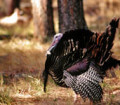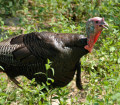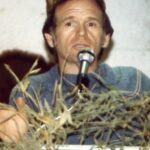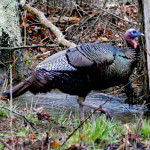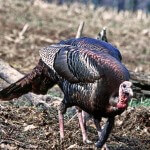John’s Note: The turkeys had gone, vanished. All the fine turkeys I’d seen the previous fall and looked forward to hunting that spring now lived on my neighbor’s property. I knew because I could hear them gobbling their heads off the first morning of spring turkey season. My neighbor had planted food plots on his land and fed the turkeys before the season started. He’d pulled the birds off my hunting-club grounds. Now my hunting club’s turkeys had become his turkeys. I’ve realized after talking to other hunters since then that I’m not the only outdoorsman who has lost his turkeys at one time or another. The springtime brings a new war every year between adjoining landowners as each owner tries to get more gobblers to come to his property. You know I’m telling the truth because this same scenario probably has happened to you or your friend. So, what’s the solution for you and your turkey flock?
To attract gobblers to your land, grow healthier turkeys and keep them on your property during hunting season,
you need to provide food for them, Dr. Grant Woods of Reeds Spring, Missouri, a longtime turkey and deer researcher, cites the importance of planting food plots for turkeys and providing food and cover for them; especially the hens. “In the spring, hens and gobblers expend a lot of energy during the rigorous breeding season and burn a huge amount of calories,” Woods explains. “To insure that your hens and your gobblers complete the breeding season in the best shape possible, make sure they have a readily-available food source. Feeding turkeys during the spring insures a long-term turkey population on your land, since hens most likely will nest close to a food source and raise their young there that will imprint on the property. Too, gobblers will move into the area because they want to be close to the hens.”
Woods says the best time of year to plant for turkeys varies, depending on the area where you live. But generally you need to plant for turkeys as soon as the region no longer has the threat of frost. Turkeys will eat more than 350 species of plants and more than 300 types of insects. Woods suggests planting milos to provide turkeys with cover, a bugging area and a huge amount of seed production for fall and wintertime. “Turkeys like a structured habitat that is short in the spring, which enables the gobblers to see the hens,” Woods reports. “Then, as the habitat increases, trying to create an umbrella habitat like ragweed is best. The hen can stick her head up like a periscope above the cover to watch for predators. The poults are so short they can run beneath the cover of the milos in case of danger. Also, the milos prevent predators from seeing the young poults.”
 More sportsmen have begun to realize that to have bronze birds in the spring on their lands to hunt that they need to have a year-round management program, which includes providing food and habitat for the adult birds and the new hatchlings. If you don’t feed and protect the poults born each spring from their many predators, including raccoons, skunks, opossums, coyotes and fox, then you won’t have jakes the next spring that will become the mature gobblers the following spring.
More sportsmen have begun to realize that to have bronze birds in the spring on their lands to hunt that they need to have a year-round management program, which includes providing food and habitat for the adult birds and the new hatchlings. If you don’t feed and protect the poults born each spring from their many predators, including raccoons, skunks, opossums, coyotes and fox, then you won’t have jakes the next spring that will become the mature gobblers the following spring.
You’ll learn many ideas for hunting turkeys in the Kindle eBook, “Turkey Hunting Tactics” by John E. Phillips. “Click here to get these books”.
About the Author
John Phillips, winner of the 2012 Homer Circle Fishing Award for outstanding fishing writer by the American Sportfishing Association (AMA) and the Professional Outdoor Media Association (POMA), the 2008 Crossbow Communicator of the year and the 2007 Legendary Communicator chosen for induction into the National Fresh Water Hall of Fame, is a freelance writer (over 6,000 magazine articles for about 100 magazines and several thousand newspaper columns published), magazine editor, photographer for print media as well as industry catalogues (over 25,000 photos published), lecturer, outdoor consultant, marketing consultant, book author and daily internet content provider with an overview of the outdoors. Click here for more information and a list of all the books available from John E. Phillips.

